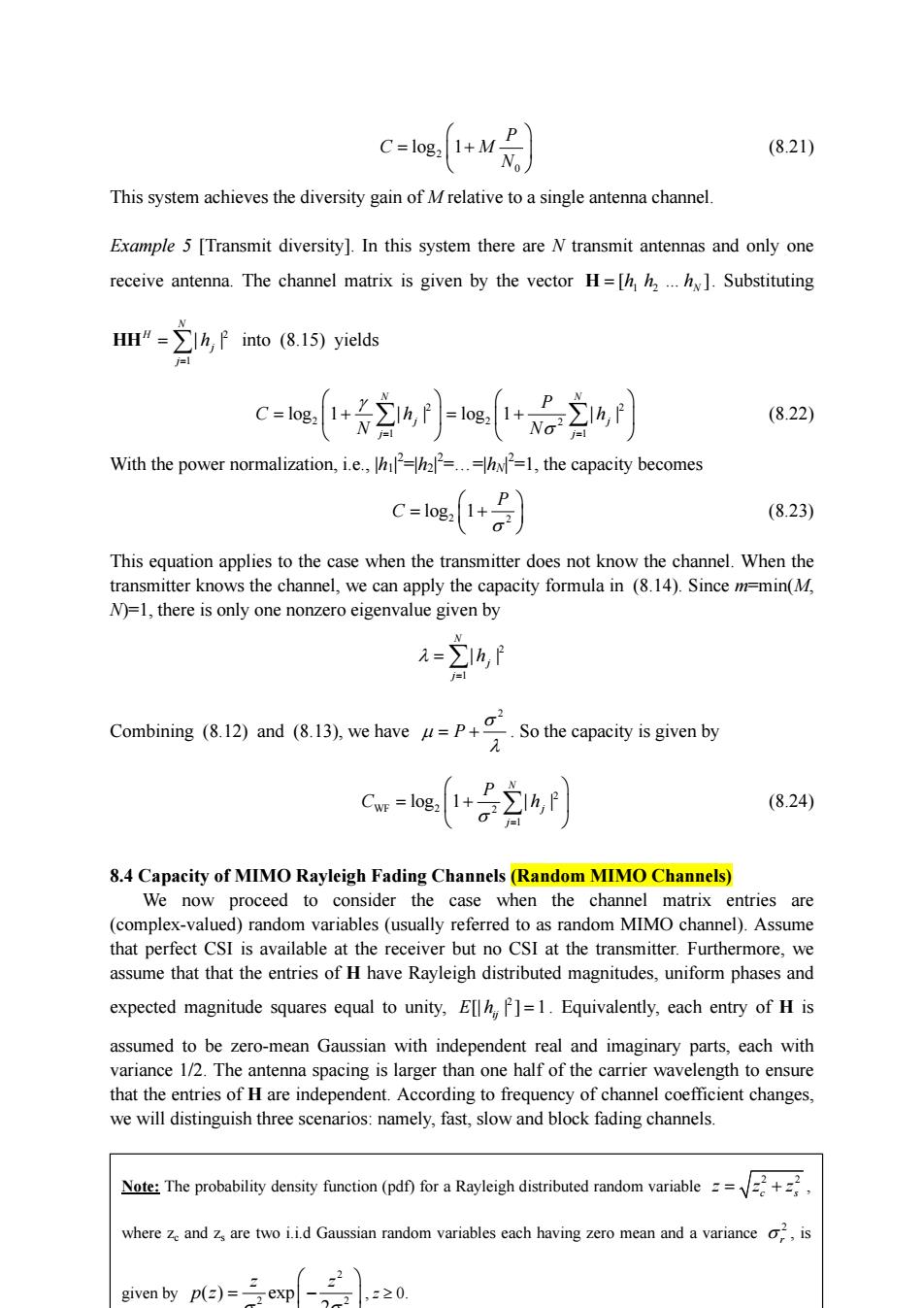正在加载图片...

c-fu别 (8.21) This system achieves the diversity gain of Mrelative to a single antenna channel. Example 5[Transmit diversity].In this system there are N transmit antennas and only one receive antenna.The channel matrix is given by the vector H=[].Substituting HH"h into (8.15)yields c=+24f小-e+石2r (8.22) N With the power normalization,i.e=1,the capacity becomes C-loe. (8.23) This equation applies to the case when the transmitter does not know the channel.When the transmitter knows the channel,we can apply the capacity formula in (8.14).Since m=min(M, N=1,there is only one nonzero eigenvalue given by =∑hf Combiang812)amd1像13),we have=P+号sote6apat的sgveny e+号2 (8.24) 8.4 Capacity of MIMO Rayleigh Fading Channels(Random MIMO Channels) We now proceed to consider the case when the channel matrix entries are Furthermore,we assume that that the entries of H have Rayleigh distributed magnitudes,uniform phases and expected magnitude squares equal to unity,E]=1.Equivalently,each entry of H is assumed to be zero-mean Gaussian with independent real and imaginary parts,each with e 1/2.The spacing s larger than one half of the ensure that the entries of H are independent.According to frequency of channel coefficient changes, we will distinguish three scenarios:namely,fast,slow and block fading channels. NoteThe probability density function (pdf)for a Rayleigh distributed random variable=+ whereandare two i.i.d Gaussian random variables each having zero mean and a variance,is ven by p()= 2012 2 0 log 1 P C M N (8.21) This system achieves the diversity gain of M relative to a single antenna channel. Example 5 [Transmit diversity]. In this system there are N transmit antennas and only one receive antenna. The channel matrix is given by the vector 1 2 [ . ] N H hh h . Substituting 2 1 | | N H j j h HH into (8.15) yields 2 2 2 2 2 1 1 log 1 | | log 1 | | N N j j j j P Ch h N N (8.22) With the power normalization, i.e., |h1| 2 =|h2| 2 =.=|hN| 2 =1, the capacity becomes 2 2 log 1 P C (8.23) This equation applies to the case when the transmitter does not know the channel. When the transmitter knows the channel, we can apply the capacity formula in (8.14). Since m=min(M, N)=1, there is only one nonzero eigenvalue given by 2 1 | | N j j h Combining (8.12) and (8.13), we have 2 P . So the capacity is given by 2 WF 2 2 1 log 1 | | N j j P C h (8.24) 8.4 Capacity of MIMO Rayleigh Fading Channels (Random MIMO Channels) We now proceed to consider the case when the channel matrix entries are (complex-valued) random variables (usually referred to as random MIMO channel). Assume that perfect CSI is available at the receiver but no CSI at the transmitter. Furthermore, we assume that that the entries of H have Rayleigh distributed magnitudes, uniform phases and expected magnitude squares equal to unity, 2 [| | ] 1 E hij . Equivalently, each entry of H is assumed to be zero-mean Gaussian with independent real and imaginary parts, each with variance 1/2. The antenna spacing is larger than one half of the carrier wavelength to ensure that the entries of H are independent. According to frequency of channel coefficient changes, we will distinguish three scenarios: namely, fast, slow and block fading channels. Note: The probability density function (pdf) for a Rayleigh distributed random variable 2 2 c s z zz , where zc and zs are two i.i.d Gaussian random variables each having zero mean and a variance 2 r , is given by 2 2 2 ( ) exp 2 z z p z , z 0